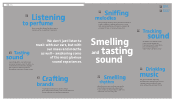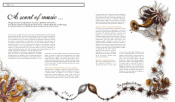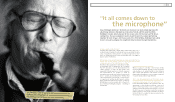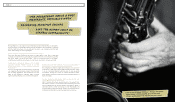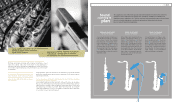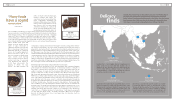Sennheiser 2010 Annual Report Download - page 8
Download and view the complete annual report
Please find page 8 of the 2010 Sennheiser annual report below. You can navigate through the pages in the report by either clicking on the pages listed below, or by using the keyword search tool below to find specific information within the annual report.
Have you experimented with different types of microphones?
On stage, we worked exclusively with condenser microphones – never
tubes. It’s a whole other story in the studio. To me, Sennheiser is
the name. I like their world view and commitment to artists. I don’t know
of any other company that pays as much attention to an artist’s needs
as Sennheiser.
You’ve accumulated a tremendous amount
of experience. After all, you’ve been in the
music business almost all your life. Now
that you’re coming up to 75, do you find it
easier or more difficult to compose, impro-
vise and play?
I keep myself fit. There are other factors as well: where you perform and with
whom. The only difference I have noticed is that every concert has become its
own moment of truth.
You’ve won prizes, written hits and traveled the world. Is there anything
you feel like you haven’t achieved?
I never really thought about what I wanted to achieve. Of course, one recognizes
the successes. But that was never my main motivation. When things don’t go
right, you have to be able to take a step back. At the same time, you can’t ever
stop rehearsing or working on yourself. That’s the bottom line. Seen superfi-
cially, the benchmark for success is set slightly too high. But what’s important
to me is that I come to terms with myself.
15
SOUND
Sound
according to
plan
The saxophone is one of the most expressive wind instruments in the world. The wail of the
saxophone can be compared to the human voice. Sometimes uninhibited – sometimes low.
Sometimes angry – sometimes soft. The first step in perfectly capturing its expression and many
facets is to find the right place to position the microphone. At least that’s the theory.
Here’s a look at it in practical application.
TENOR SAXOPHONE
dynamic microphone
In the studio, tenor saxophonists use
dynamic microphones fitted on a
stand 1. The microphone 2 is tilted
toward the opening of the saxo-
phone’s bell 3, giving every tone the
same weight. The further away the
saxophonist stands from the mic, the
more neutral the tone. The closer he
is, the more intimate. The disadvan-
tage is that it can intensify any back-
ground noise, such as the valve keys
opening and closing.
TENOR SAXOPHONE
clip-on microphone
For performances on stage, a wire-
less transmitter is mounted to the
tenor saxophone’s bell 1. The trans-
mitter 2 is connected to the micro-
phone 3, which is positioned directly
above the bell. A wireless microphone
system gives a saxophonist tremen-
dous freedom to move around on
stage during a live performance
without forfeiting sound quality.
SOPRANO SAXOPHONE
clip-on microphone
A gooseneck wireless microphone is
typically used on stage for a soprano
sax because it gives the musician
more freedom of movement. Trans-
mitter and battery 1 connected by a
cable to the microphone 2 can be
mounted either on the saxophone or
the musician’s belt. The microphone
3 is usually located near the right-
hand valve keys so that the sound is
amplified evenly.
1
2
3
1
2
3
2
3
1
I have a whole collection of Selmer saxophones,
but my favorite is the legendary
tenor model Mark VI.
Sennheiser’s MD441 dynamic microphone
is a classic. I always have it on hand
in my studio for saxophone recordings.




